Submitted:
24 August 2024
Posted:
27 August 2024
Read the latest preprint version here
Abstract
Keywords:
1. Introduction
1.1. Background of the Study
2. Material and Methods
2.1. Site Descriptions
2.2. Sampling Methods
2.3. Methods of Data Collection
2.4. Data Analysis
3. Result and Discussion
3.1. Soil and Water Conservation Analysis
| Activity | Unit | Quantity |
|---|---|---|
| Soil erosion protection (cutoff drains, hillside terraces, stone-faced soil bands) | m² | 4854 |
| Wire mesh/Gabion check dams | m² | 1250 |
| Stone and wood check dams | m² | 2700 |
| Deep trench and retaining wall | m² | 5130 |
| Micro basin/half moon | m² | 1210 |
| Swamp area development | No. | 5 |
| Biological method (planting grass and trees) | m | 4700 |
| Name of watershed | Non-educated | Diploma | Degree | |||||||
| BA | MSC | PHD | ||||||||
| NO. | % | NO. | % | NO. | % | |||||
| No. | % | No. | % | |||||||
| DAM A | 0 | 0 | 0 | 0 | 2 | 10 | 40 | 80 | 2 | 10 |
| DAM B | ||||||||||
| total | 100 | |||||||||
| Respondent age | No. of respondent | Percent % |
| 25-30 | 2 | 5 |
| >30 | 42 | 95 |
| Total | 100 |
3.2. The Key Watershed Problems and the Root Causes
3.2.1. Dam A Watershed
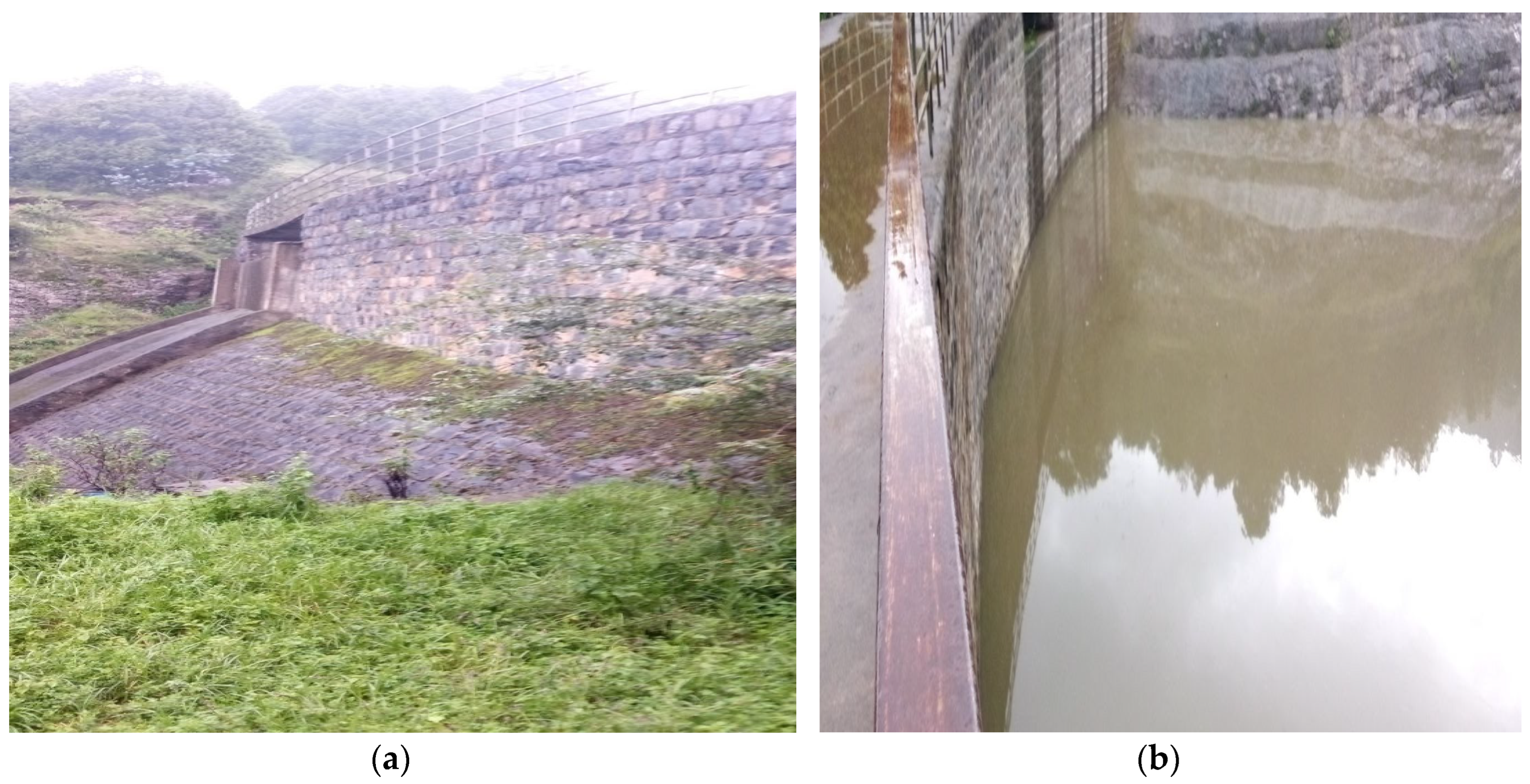
3.2.1.1. Cause of Problem in Dam A
| Rank | Cause of soil erosion | Number of respondents | Percent % |
| 1 | Mismanagement | 20 | 40% |
| 2 | Land slope | 10 | 25% |
| 3 | Lack of expert | 6 | 20% |
| 4 | Excessive rainfall | 5 | 10% |
| 5 | Lack of money | 3 | 5% |
| Total | 44 | 100 | |
3.2.2. Dam B Watershed
3.2.2.1. Cause of the Problem in the Dam B
| Rank | Cause of soil erosion | Number of respondents | Percent % |
| 1 | Mismanagement | 20 | 40% |
| 2 | Land slope | 10 | 25% |
| 3 | Lack of expert | 6 | 20% |
| 4 | Excessive rainfall | 5 | 10% |
| 5 | Lack of money | 3 | 5% |
| Total | 44 | 100 | |
3.3. Biophysical Factor
3.3.1. Slope Classification
3.4. Analysis of Watershed Management (Conservation) Practices
3.4.1. Soil and Water Conservation Practices
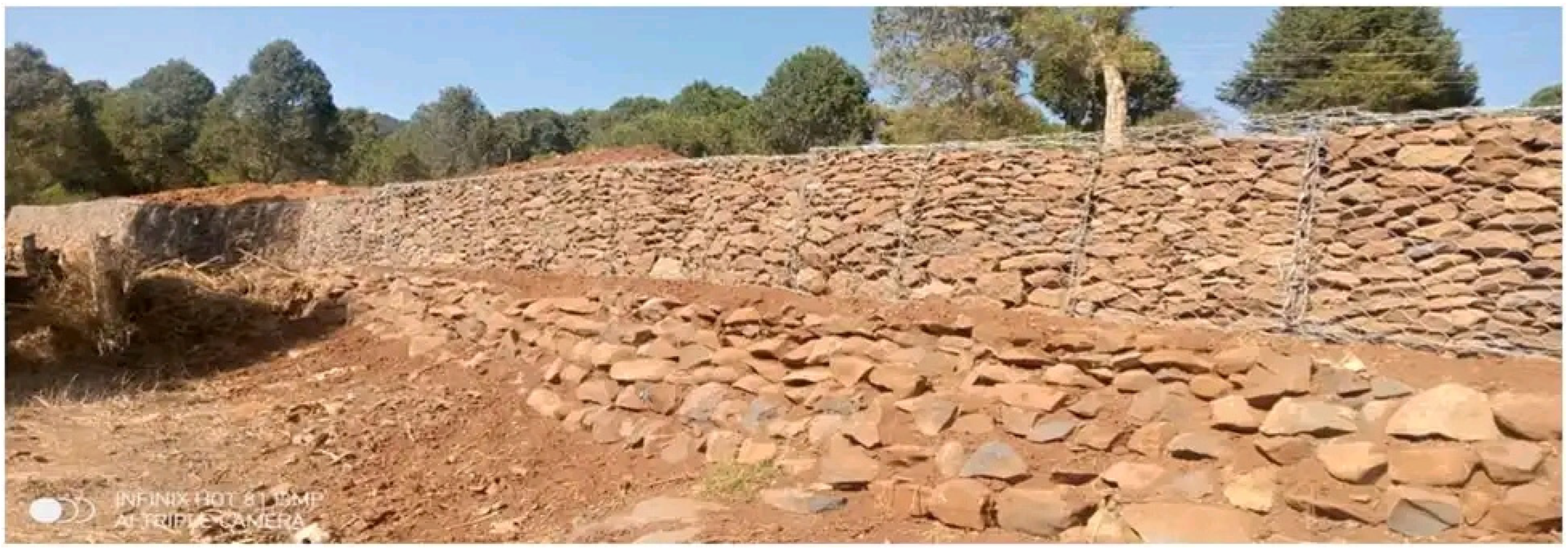
3.4.2. Traditional and Newly Introduced Soil and Soil Water Conservation Practices
3.4.2.1. Cut-Off Drain
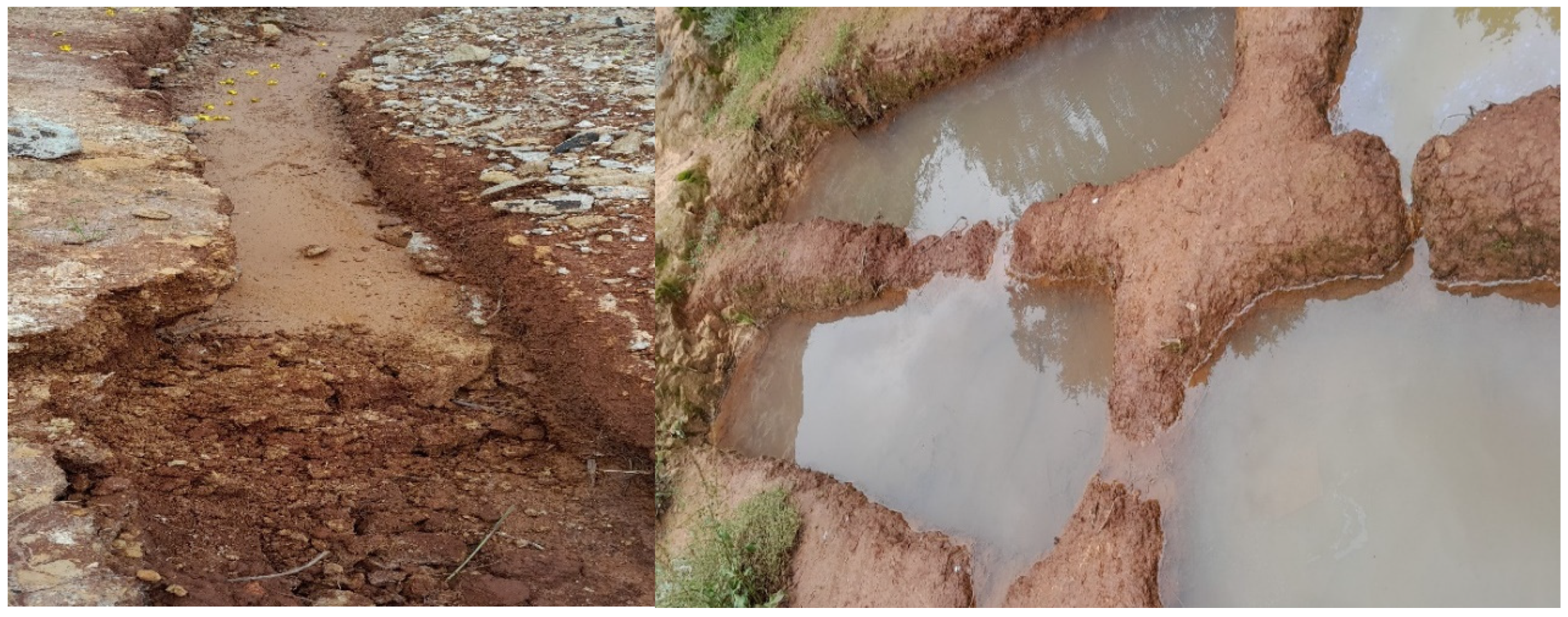
3.4.2.3. Stone Bunds

3.4.2.4. Soil Fertility and Management Practices
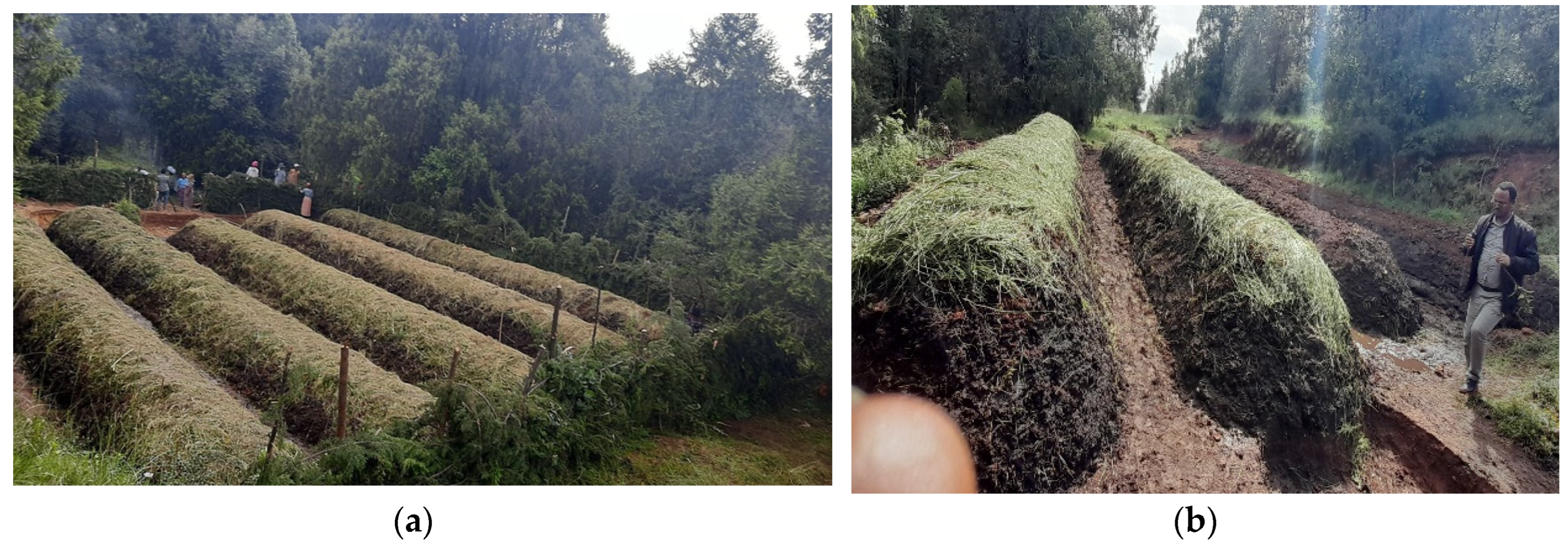
| Purpose of use of compost manure | Number of respondents in both watershed | Total | Percent % | |
| Dam A | Dam B | |||
| Soil fertility | 44 | 44 | 44 | 100 |
| Fuel | 0 | 0 | 0 | 0 |
| Both soil fertility and fuel | 0 | 0 | 0 | 0 |
| No use any | 0 | 0 | 0 | 0 |
3.4.3. Participation of Households in Soil and Water Conservation
3.4.3.1. Participation in Implementation
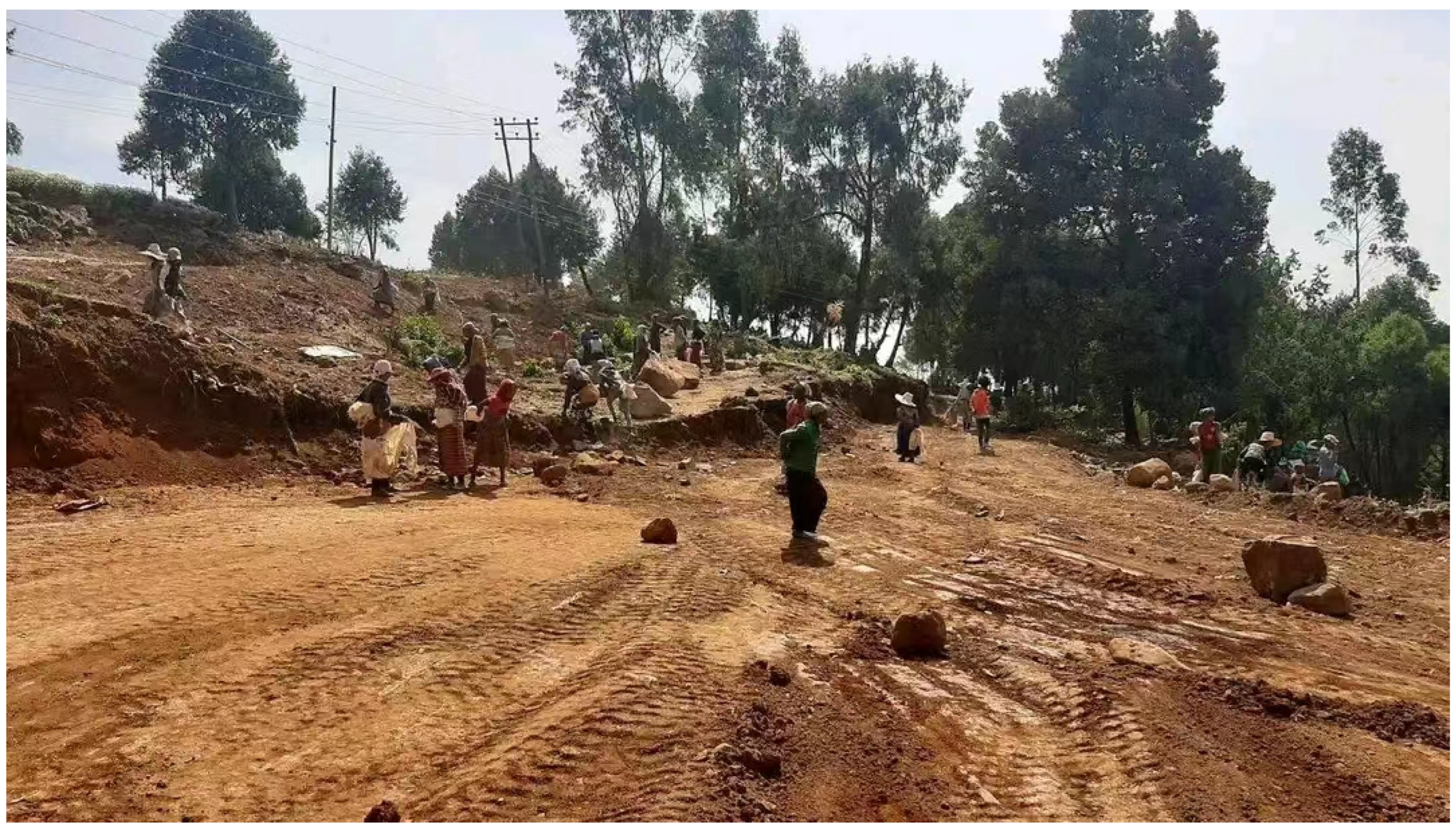
- ✓
- Utilizing total maximum daily load assessments, support watershed approaches to nonpoint source pollution control, habitat preservation, water quality permits, and other water resource protection and restoration operations.
- ✓
- Target designated wellhead protection programmer protection areas and overall source water protection areas as a high priority for various federal and state programmers by using their watershed strategy.
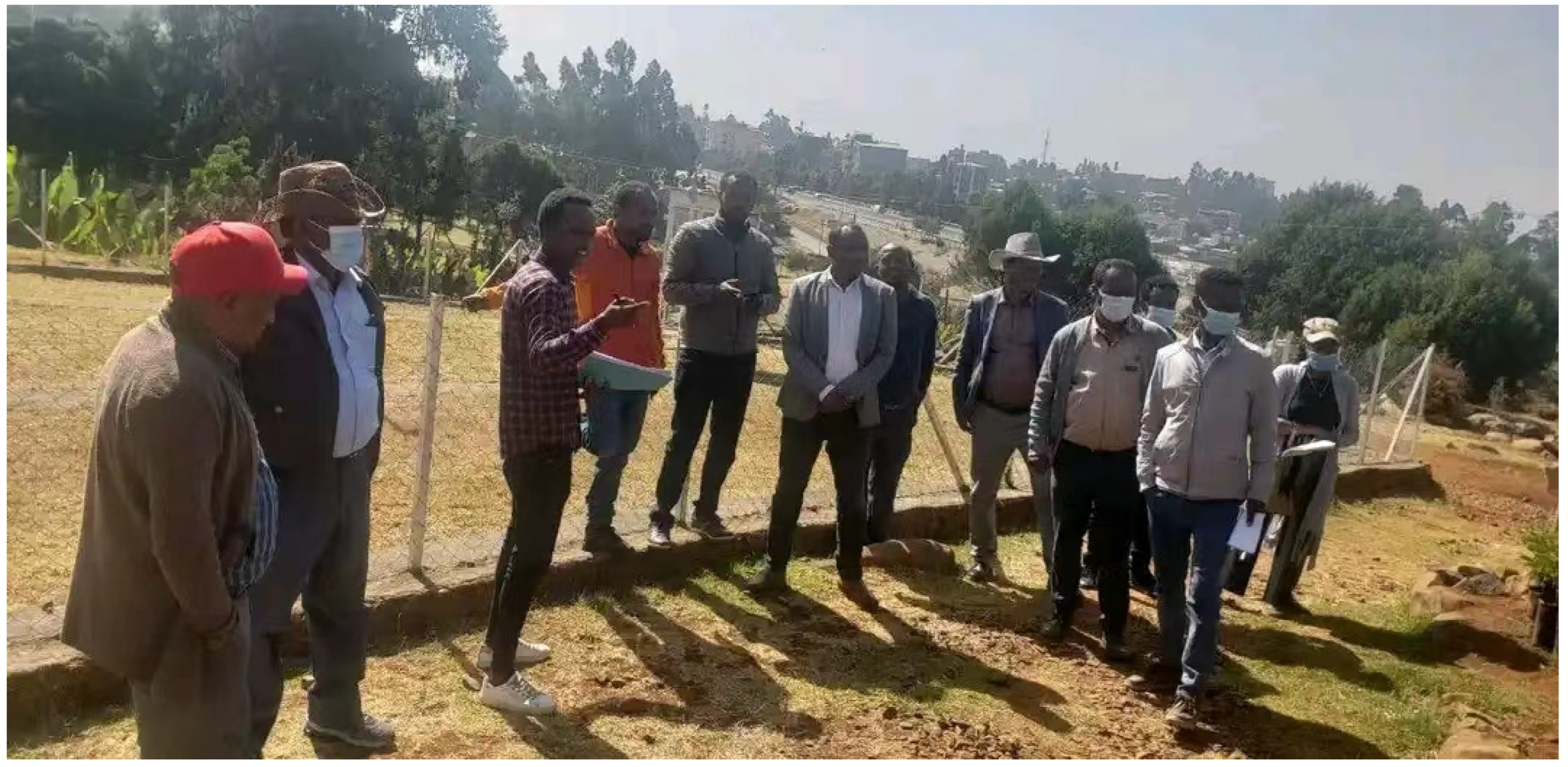
3.4.3.2. Participation in Maintenance
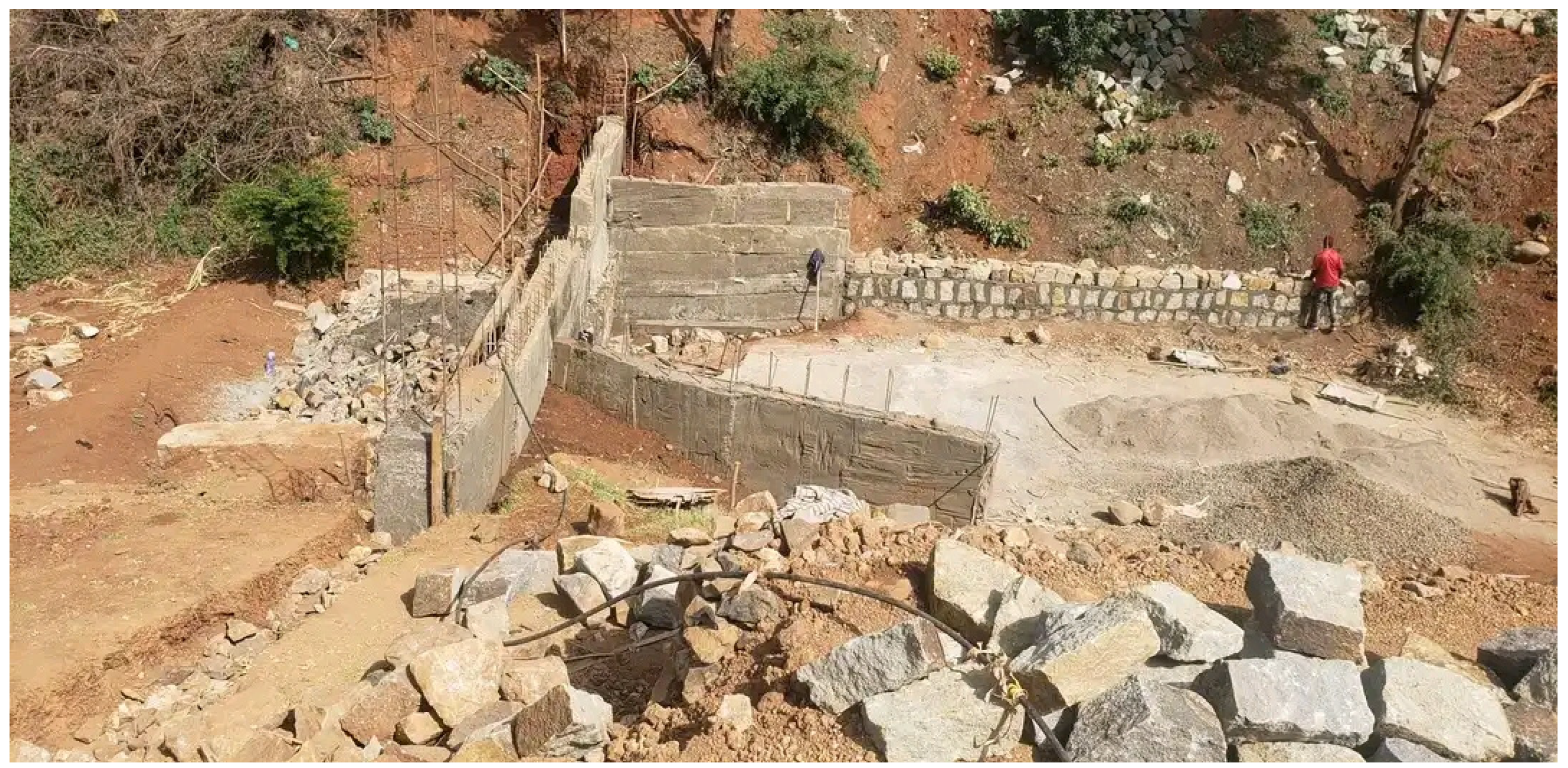
3.4.3.3. Watershed Management Approach
3.5. Role of Watershed Management for Plants
4. Conclusions
References
- Amhara National Regional State of the Federal Republic of Ethiopia (ANRSFRE) in collaboration with Global Environmental Facility (GEF) and International Fund for Agricultural Development (IFAD), (2008). Community-based integrated natural resource management in Lake Tana watershed, Ethiopia. Pp. 28.
- Associated Programme on Flood Management (APFM) (2007) Formulating a basin flood management plan: A tool for integrated flood management. World Meteorological Organization/ Global Water Partnership.
- Ashby, J. (1996). What do we mean by participatory research in agriculture: participatory research and gender analysis for technology development, CIAT Publication No. 294, Cali, Colombia.
- Bayley PB (1995) Understanding large river-floodplain ecosystems. Bioscience 45:153–158.
- Bekele Tesemma, A. (2007). Profitable agro-forestry innovations for eastern Africa experience from agro-climatic zones of Ethiopia, India, Kenya Tanzania and Uganda. World Agro-forestry Centre (ICRF), Eastern Africa.
- Bruijnzeel LA (2004) Hydrological functions of tropical forests: not seeing the soil for the trees? Agri Ecosyst Environ 104:185–228.
- Calder IR, Smyle J, Aylward B (2007) Debate over flood-proofing effects of planting forests. Nature 450:945.
- Chambers R, Conway G (1991) Sustainable rural livelihoods: practical concepts for the 21st century. Institute for Development Studies (IDS) discussion paper no. 296. Institute for Development Studies, London.
- Chang L, Shen H, Wang Y, Huang J, Lin Y (2010) Clustering-based hybrid inundation model for forecasting flood inundation depths. J Hydrol 385:257–268.
- European Commission (EC) (2007) Directive 2007/60/EC of the European Parliament and the council of 23 October 2007 on the assessment and management of flood risks. Off J Eur Union L 288:27–34.
- FAO. 1986. Watershed management in Asia and Pacific: Needs and Opportunities for Active Participation Study report-FAO: RAS/85/017, FAO, Rome, 166 pp.
- FAO, 2000. Rural Poverty, Risk and Development, by M. Faf champus, FAO economic and social development paper No. 144. Rome.
- Food and Agriculture Organization of the United Nations (FAO) (2006) The new generation of watershed management programmes and projects. FAO forestry paper 150. FAO, Rome.
- Food and Agriculture Organization of the United Nations (FAO) (2013) Forests and water. International momentum and action. Food and Agriculture Organization of the United Nations, Rome.
- Fikadu Erenso, 2021. Identification, characterization and valuation of eco-system services provided Gullele Botanical Garden, Addis Ababa, Ethiopia.
- Fikru Assefa, 2009. Assessment of adoption behavior of soil and water conservation practices in the Koga watershed, highlands of Ethiopia. A Thesis Presented to the Faculty of the Grad School of Cornell University Master of Professional Studies.
- Hinchcliffe F, I Guijt, JN Pretty and P Shah, 1995. New horizons: The economic, social and environmental impacts of participatory watershed development. IIED. Gatekeeper Series 50. pp 3-20.
- Inter-American Development Bank (IDB), 1995. Concepts and issues in watershed management, IDB, Washington, D. C.
- IFPRI (International Food Policy Research Institute), WUR (Wageningen University and Research Center) and EEPFE (Environmental Economics Policy Forum of Ethiopia),2005. Poverty and Land Degradation in Ethiopia: How to Reverse the Spiral?
- Jeffery, R., Vira, B. 2001. Conflict and cooperation in participatory natural resource management, Palgrave, cited in: Dube, D., Swatuk, L. 2002. Stakeholder participation in the new water management approach: a case study of the Save catchment, Zimbabwe, Physics and Chemistry of the Earth, Vol. 27, 867-874.
- Johnston, J. 2001. Econometric Methods. Fourth edition, University of California, Irvine. 496p.
- Johnson N, Ravnborg HM, Westermann O, Probst K (2002) User participation in watershed management and research. Water Policy 3:507–520.
- Johnson CL, Priest SJ (2008) Flood risk management in England: a changing landscape of risk responsibility? Int J Water Resour D 24:513–525.
- Kahsay B, (2004) land use and land cover changes in the central highlands of Ethiopia: the case of Yerer Mountain and its surroundings a thesis submitted to the school of graduate studies, Addis Ababa University.
- Kerr, J. M., Sanghi, N. K., Sriramappa, G. 1996. Subsidies in watershed development projects in India: distortions and opportunities, Gatekeeper Series No. 61, International Institute for Environment and Development, London.
- Khan, M.A. 2002. Watershed Management for Sustainable Agriculture. Agrobios (India), Chopasni Road, Jodhpur, 237 pp, India.
- Khatibi R (2011) Evolutionary systemic modelling of practices on flood risk. J Hydrol 401:36–52.
- MOARD 2005. Guide line for integrated watershed management, Addis Ababa, Ethiopia.
- Mostert E, Junier SJ (2009) The European flood risk directive: challenges for research. Hydrol Earth Syst Sci Discuss 6:4961–4988.
- Pretty, J., Ward, H. 2001. Social capital and the environment, World Development, Vol. 29, No. 2, 209-227. Rhoades, R. E. 1998. Participatory watershed research and management: where the shadow falls, Gatekeeper Series No. 81, International Institute for Environment and Development, London.
- Recha JW, Lehmann J, Walter MT, Pell A, Verchot L, Johnson M (2012) Stream discharge in tropical headwater catchments as a result of forest clearing and soil degradation. Earth Interact 16: Paper No. 13, 1–18.
- Rhoades, R.E. 1998. Participatory watershed research and management: where the shadow falls, Gatekeeper Series No. 81, International Institute for Environment and Development, London.
- Roggeri H (ed) (1995) Tropical freshwater wetlands: a guide to current knowledge and sustainable management, Developments in hydrobiology (Netherlands) 112. Kluwer Academic Publishers, Dordrecht. ISBN 0-7923-3785-9.
- Sahlemedhin, S. 1999. Ethiopia: Integrated Soil Management for Sustainable Agriculture and Food Security in Southern and East Africa. Proceedings of the expert consultation, 8-12 December, 1997, Harare, agritex, FAO, Rome, pp. 197-210.
- Stocking, M. 1996. Land management for sustainable development: farmer’s participation.
- In: Stocking, M., 2001. Handbook for the field assessment of land degradation, Eathscan, London.
- Talemos et al, 2021. Gullele Botanic Garden, Addis Ababa (Ethiopia): current status, challenges and opportunities.
- Temesgen Zewde 2012. Factors influencing land degradation in the Bilatte watershed: The case of Dimtu and Shelo sub-watersheds, Southern Ethiopia. A Thesis Submitted to School of graduate studies, Institute of Technology Department of Biosystem and Environmental Engineering. Hawassa University, Ethiopia.
- Tesfaye Habtamu 2011. Assessment of sustainable watershed management approach case study Lencha Dima, Tsegur Eyesus and Dijjil Watershed. A Project Paper Presented to the Faculty of the Graduate School of Cornell University in Partial Fulfillment of the Requirements for the Degree of Master of Professional Studies.
- Falkenmark, M., & Rockström, J. (2013). Balancing water for humans and nature: The new approach in ecohydrology. Earthscan. [CrossRef]
- Mwangi, H. M., Julich, S., & Feger, K.-H. (2020). Introduction to Watershed Management. In L. Pancel & M. Köhl (Eds.), Tropical Forestry Handbook (pp. 1-23). Berlin, Heidelberg: Springer Berlin Heidelberg.
- Programme, U. W. W. A., & UN-Water. (2012). Managing Water Under Uncertainty and Risk (Vol. 1): Unesco.
- Seta, T., & Telake, B. (2021). Gullele Botanic Garden, Addis Ababa (Ethiopia): current status, challenges and opportunities. Sibbaldia: the International Journal of Botanic Garden Horticulture, 21. [CrossRef]
- United Nations Environment Programmer (UNEP) (2005) Water and wastewater reuse. An environmentally sound approach for sustainable urban water management.
- UNEP Collaborating Centre on Water and Environment, Nairobi United Nations Environment Programmer (UNEP) (2012) The UN-water status report on the application of integrated approaches to water resources management.
- Wahren A, Schwa¨rzel K, Feger KH (2012) Potentials and limitations of natural flood retention by forested land in headwater catchments: evidence from experimental and model studies. J Flood Risk Manage 5:321–335.
- World Meteorological Organization (WMO) (2012) Technical materials for water resources assessment, vol 2, Technical report series. World Meteorological Organisation, Geneva. ISBN 978-92-63-11095-4.
- Yeraswork, A. (2000). Twenty Years to Nowhere: Property Rights, Land Management and Conservation in Ethiopia. Lawrenceville, New Jersey: Red Sea Press.

Disclaimer/Publisher’s Note: The statements, opinions and data contained in all publications are solely those of the individual author(s) and contributor(s) and not of MDPI and/or the editor(s). MDPI and/or the editor(s) disclaim responsibility for any injury to people or property resulting from any ideas, methods, instructions or products referred to in the content. |
© 2024 by the author. Licensee MDPI, Basel, Switzerland. This article is an open access article distributed under the terms and conditions of the Creative Commons Attribution (CC BY) license (https://creativecommons.org/licenses/by/4.0/).




